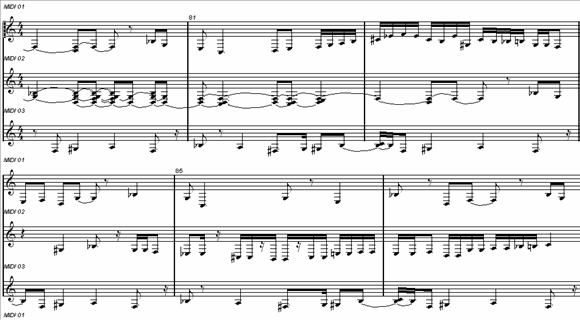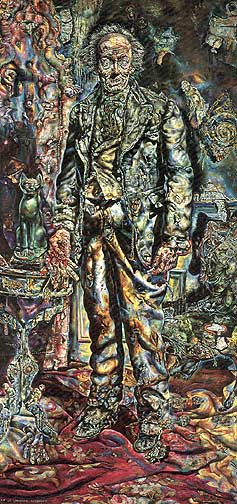View current page
...more recent posts

"Subharmonic Duo" (Piano) [mp3 removed]
Kind of a slow baroque modernist blues composition for piano, using the same notes as "Subharmonic Duo" minus the beats. The score above is an except near the end. (The title has been changed.)
"Dyspeptic Bass" [mp3 removed]
I spent the holidays working on songs and finally sat down with the manual and learned to use a hardware sequencer. I originally had the idea I would write all my material in the computer but someone on a chatboard I look at described the Electribe R-1 mkii as a "sketchbook" for rhythmic ideas and that idea appealed. (I got one a while back--they're pretty cheap--but had mainly been using it as a tone generator and a source of MIDI to mangle.) Of course the sketches can be recorded as audio or MIDI and developed further in the computer. The song above uses one of my first "drawings"--I kept the rhythm simple and put most of my energy into a kind of extended slow motion prog solo played on a different instrument, a software synth. [/music diary]
Update: this is the same basic melody as "Subharmonic Duo" but I called it "Dyspeptic Bass" because the synthesizer sounds gastronomically challenged. Maybe it's time for a Pink Floyd parody called "Gastronomy Domine."
In the comments to the previous post where I was complaining about the emphasis on timbre (musical sound or texture) in a recent New York Times story, p.d. reminds me that changes in timbre are the creative engine behind, like, all my favorite music (techno, hiphop, and so forth). He tells a great story about "Berry Gordy making the engineers build a radio transmitter and everyone heading out into the car to check how the motown test masters sounded...and remix, re-eq, recut, and test, etc...for the whole day because he knew if it didn't sound 'right' on the radio it wouldn't sell." p.d. points out how many current hiphop hits have built on such sonic refinements, from Motown right up through '90s drum and bass experiments, turning them into main attraction.
All true, but I don't think the sound scientist I was hectoring, Daniel Levitin, was talking about artists who consciously base their music on equalization or synth textures, a la the Detroit techno guys. He means monster hits, which I maintain rely as much on the marketing of personality and yes, old fashioned musical hooks. A good case in point was Cher's "Believe," to which the Times devoted an anatomy-of-a-chart-topper story several years ago. It was quite funny: Cher came off as the grumpy CEO of her corporate musical enterprise, complaining at development meetings to the teams that had various parts of the song parceled out to them. Seems they had the verses in the pipeline for six years but the chorus was eluding them (or maybe the reverse). She admonished one team to "go out and get more pain in their lives" to develop an effective hook. Someone had some weak lines and tried them with the vocoder and the rest is musical history. So, yes, timbre put the song over the top but the hit also resulted from nuts and bolts Tin Pan Alley songwriting. The acoustic scientist Levitin has discovered an interesting fact about current music but is announcing it as a principle. And no offense to anyone in a lab about the dig in the last post--my point is mainly that art is its own kind of rocket science but journalists love to dumb it down by reducing it to something quantifiable.
One should always be leery when scientists attempt arts criticism. The New York Times is not leery--it eats it up, witness all the stories about fractal analysis of Pollock paintings. Yesterday it ran an article about Daniel Levitin, a big time pop music producer who pulled out of the game in the early '80s and became an acoustic scientist. Check out this line of argument:
The subtlest reason that pop music is so flavorful to our brains is that it relies so strongly on timbre. Timbre is a peculiar blend of tones in any sound; it is why a tuba sounds so different from a flute even when they are playing the same melody in the same key. Popular performers or groups, Dr. Levitin argued, are pleasing not because of any particular virtuosity, but because they create an overall timbre that remains consistent from song to song. That quality explains why, for example, I could identify even a single note of Elton John’s “Benny and the Jets.”I believe it was the Beatles' manager Brian Epstein who had the industry visions based on the boys' looks, pop hook writing ability, stage energy and the like. After their breakthrough to larger fame Pete Townshend was still calling the production of their tracks "flippin' lousy" (the '60s TV interview where he says that is one of the funnier moments in The Kids Are Alright). As for being able to recognize a piano note from "Benny and Jets," who would want to? After the popular musical creativity of groups such the Jimi Hendrix Experience and the Doors, "Benny" was pure retrograde fluff. Levitin's idea that musical fame is based on timbre (or the continuity thereof from song to song) is the kind of cynicism that supposedly drove him out of the music biz years ago. As for the success of Elton John, that can be attributed to marketing and the burnout of '60s music rather than "timbre" (as long as we're being cynical).
“Nobody else’s piano sounds quite like that,” he said, referring to Mr. John. “Pop musicians compose with timbre. Pitch and harmony are becoming less important.”
Dr. Levitin dragged me over to a lab computer to show me what he was talking about. “Listen to this,” he said, and played an MP3. It was pretty awful: a poorly recorded, nasal-sounding British band performing, for some reason, a Spanish-themed ballad.
Dr. Levitin grinned. “That,” he said, “is the original demo tape of the Beatles. It was rejected by every record company. And you can see why. To you and me it sounds terrible. But George Martin heard this and thought, ‘Oh yeah, I can imagine a multibillion-dollar industry built on this.’
“Now that’s musical genius.”
Happy New Year.
Acen - Trip II the Moon [YouTube]
(I like the bouncing balls and spinning discs in this early 90s breakbeat 'ardkore vid. And the stop motion centipede that twirls into a dymaxion cocoon and emerges as a helicopter bug. The claymation alien repeatedly running toward the screen makes me think I'm losing my mind. And the music is sublime.)
Thanks, Jonathan! More soon.
MRiver's "CYA" end of the year recap is here. I greatly appreciate the mention of my artMovingProjects show in the Nerdz Rising '06 category. End of the year selections by Rick Silva and bloggy are also published on the MTAA blog.

Ken Lum - Steve - The best repro I could find on Google Images, enlarged in html. Lum took pictures of "normal" people and made deluxe graphics for them so they could be bigger than life, "special." "Steve" haunts me, I don't know why.

Portrait used in the film The Picture of Dorian Gray, painted by Chicago imagist/outsider Ivan Albright. The 1945 film is tres creepy. One thing it avoids is what exactly Dorian is doing to destroy the young men of society. Wikipedia opines:
The name "Dorian" has connotations of the Dorians, an ancient Hellenic tribe. Robert Mighall suggests that this could be Wilde hinting at a connection to "Greek love", a euphemism for the homoeroticism that was accepted as everyday in ancient Greece. Indeed, Dorian is described using the semantic field of the Greek Gods, being likened to Adonis, a person who looks as if "he were made of ivory and rose-leaves." However, Wilde does not mention any homosexual acts explicitly, and descriptions of Dorian's "sins" are often vague, although there does appear to be an element of homoeroticism in the competition between Lord Henry and Basil, both of whom compete for Dorian's attention. Both of them make comments about Dorian in praise of his good looks and youthful demeanour, Basil going as far to say that "as long as I live, the personality of Dorian Gray will dominate me." However, whilst Basil is shunned, Dorian wishes to emulate Lord Henry, which in turn rouses Lord Henry from his "characteristic languor to a desire to influence Dorian, a process that is itself a sublimated expression of homosexuality."Yet one of the first people annihilated in the film is Angela Lansbury, who Dorian courts and then abandons. So I think we can assume he's bi. The actor who plays Dorian, Hurd Hatfield, is quite the icy mannikin, which adds to the weirdness.
The later corruption of Dorian seems to make what was once a boyish charm become a destructive influence. Basil asks why Dorian's "friendship is so fatal to young men", commenting upon the "shame and sorrow" that the father of one of the disgraced boys displays. Dorian only destroys these men when he becomes "intimate" with them, suggesting that the friendships between Dorian and the men in question become more than simply Platonic. The shame associated with these relationships is bipartite: the families of the boys are upset that their sons may have indulged in a homosexual relationship with Dorian Gray, and also feel shame that they have now lost their place in society, their names having been sullied; their loss of status is encapsulated in Basil's questioning of Dorian: speaking of the Duke of Perth, a disgraced friend of Dorian's, he asks "what gentleman would associate with him?"
